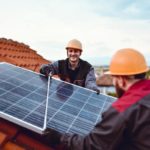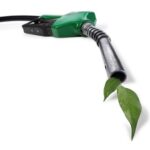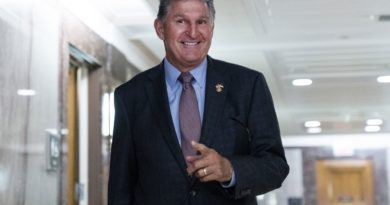The Pandemic Effect – Efficiency Performance and Energy Affordability Challenges in 2020 – SACE – Clean Energy News
Energy Disrupter
The COVID-19 pandemic made energy bills even more unaffordable for families in the Southeast, while utility energy efficiency programs also took a hit. New data shows how the response taken by each utility impacted their efficiency performance in a year like no other.
Forest Bradley-Wright | April 5, 2021
| Energy Efficiency, Florida, Georgia, North Carolina, South Carolina, Utilities
This is the seventh in a series of blogs tied to SACE’s third annual “Energy Efficiency in the Southeast” report. The first six blogs in this series featured the publication of this year’s efficiency report; Duke Energy’s performance and ways it can still strive for higher savings; pressures on Dominion Energy to increase efficiency in its integrated resource plan; TVA’s decision to largely abandon its efficiency programs altogether; and how Florida’s ongoing efficiency rules reform could reverse years of low performance. For our final installment in this series, we look at the effect of the COVID-19 pandemic on energy affordability and how a year like no other affected utility efficiency program performance.
Download the Report
Read the Report Series
Watch the report webinar
In 2020, COVID-19 fundamentally disrupted Southeast efficiency programs, while intensifying energy insecurity issues for millions of already vulnerable households.
Our third annual “Energy Efficiency in the Southeast” report examined some of the impacts the pandemic was having on customers and utility efficiency program delivery. But only now, through recent regulatory filings, are we starting to see the effects on utility efficiency performance in 2020 through the data.
Utility efficiency program performance (not surprisingly) declined in 2020, as lockdowns and the need for new safety protocols disrupted some program delivery channels. At the same time, the economic downturn impacted customers’ ability to pay their energy bills. Utility responses varied, but across the region, more action is still needed to adopt energy efficiency programs and respond to the financial challenges customers continue to face due to the pandemic.
Pandemic Exposes Energy Affordability Issues and Intensifies the Need for Energy Efficiency
Energy efficiency is a proven low-cost clean energy resource, but Southeastern utilities and regulators have underinvested and deprioritized it. As a result, households in many Southeastern states have some of the highest electricity usage and highest monthly energy bills in the nation.
Because of this, unaffordable energy bills have been a fact of life for low-income households in the Southeast for many years. The economic hardship caused by the pandemic greatly intensified this problem for millions of households and laid it bare for all to see.

Meanwhile, utilities have been quick to ask regulators to protect them from pandemic-related revenue losses from unpaid bills – which then get passed on to all customers. Temporary moratoriums on utility disconnection provided vital short-term protection for customers, but now families are struggling to pay new high energy bills while also bearing the added cost of repaying past due balances. Financially struggling customers need relief, both immediate and long-term. Energy efficiency is key to breaking this downward spiral – if utilities and regulators will take action.
New Safety Challenges Disrupt Efficiency Program Operations
In the early days of the pandemic, on-site efficiency services ground to a halt across the country, to protect workers and customers from exposure to COVID-19. This led to significant declines in efficiency program savings. Unfortunately, the steepest declines were often in programs that serve, low-income customers – the very people who needed them most.
To resume efficiency services, utilities had to develop new safety protocols and make changes to how programs were delivered. As discussed further below, some utilities showed initiative, flexibility, and a commitment to overcome the new challenges, while others were slower to innovate. A few examples of program delivery adaptations implemented in the Southeast include:
- Offering virtual audits in place of in-home visits,
- Increasing distribution of do-it-yourself energy efficiency kits,
- Deploying more LED light bulbs to make up for savings elsewhere,
- Increasing customer rebates for select measures,
- Shifting to midstream delivery channels for equipment replacement, and
- Expanding efficiency offerings through utility-run online marketplaces.
Efficiency Takes a Hit, But Performance Varies by Utility
DUKE ENERGY CAROLINAS
Duke Energy Carolinas (DEC) is the Southeast regional leader for energy efficiency performance and was among the first utilities to implement new safety protocols and resume in-home energy efficiency services after the pandemic. This, combined with several of the program adjustments described above, helped the utility achieve 648 GWh of efficiency savings – approximately 85% of its 2020 targets. This is, however, a 25% decline in savings from the previous year. Still, DEC is likely to retain its status as the regional efficiency performance leader in 2020, owing to its more mature program portfolio and its willingness to proactively adjust its approach in the face of unprecedented challenges.
GEORGIA POWER
Following the pandemic, Georgia Power struggled to adapt. It made few changes to its programs and funding allocations, and never resumed in-home efficiency services for the remainder of the year. The Georgia Public Service Commission (PSC) recently increased Georgia Power’s efficiency annual saving targets by 15% for the years 2020-2022. But because the company switched many of its program implementers last year, some programs had not even begun when the COVID-19 pandemic struck – throwing its 2020 savings trajectory into a tailspin. By September, Georgia Power had achieved only 27% of its annual target, while making it clear it would not reach its first-year savings goal.
Because Georgia Power did not institute new safety protocols to resume in-home efficiency programs in 2020, the utility’s low-income Home Energy Efficiency Assistance Program (HEEAP) never launched – leaving a critical customer segment unserved during the economic crisis. It wasn’t until the fourth quarter that adjustments were made to instead send do-it-yourself efficiency kits to approximately 8,000 low-income customers. Still, the utility claimed 4.8 GWh of savings from those kits, equivalent to 71% of its HEAPP target. The table below reflects Georgia Power’s 2020 energy efficiency performance.
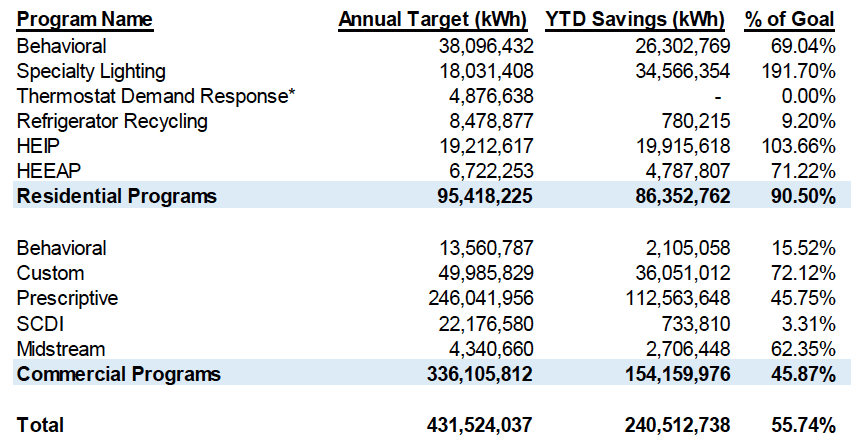
Ultimately, Georgia power was able to achieve 90.5% of its residential efficiency savings target for 2020, largely as a result of its specialty lighting program, which delivered double its savings projections. Commercial efficiency program savings had been expected to account for more than twice as much total savings as residential programs, but in 2020 were way down at 45.87% of the target. Combined, Georgia Power’s total efficiency savings were 241 GWh – about 55.74% of the savings required by the Georgia Public Service Commission for 2020. Perhaps most disappointing, though, there is no plan to shift funding forward or attempt to make up any of the lost savings from 2020 in subsequent years.
DOMINION ENERGY SOUTH CAROLINA
Dominion Energy South Carolina also had its savings targets for 2020 increased by regulators the previous year. There were major differences in which programs performed well, versus those that did poorly, between Georgia Power and Dominion. For instance, lighting and home energy reports underdelivered, for Dominion but performed well for Georgia Power. On the other hand Dominion’s low-income Neighborhood Energy Efficiency Program, Heating & Cooling, and the Small Business Energy Solutions programs all over-performed, but were more challenging for Georgia Power. Altogether, Dominion delivered 54 GWh of efficiency savings, 76% of its annual goal. The table below reflects Dominion’s efficiency performance in 2020.
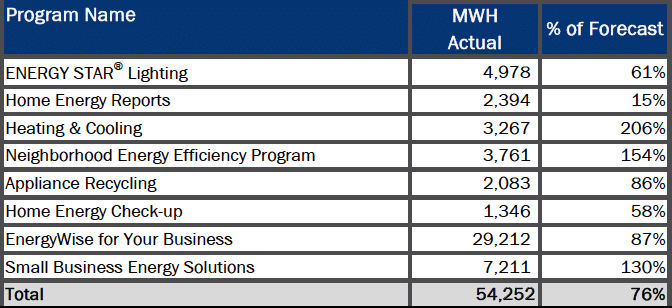
FLORIDA UTILITIES
Florida utilities were all over the place, which is not surprising given the historically hostile stance some electric companies have towards energy efficiency, and the remarkably low savings goals set by regulators in that state.
Duke Energy Florida continues to achieve just a small fraction of the savings (proportionately) as those delivered by its sister utilities in the Carolinas. But it still easily surpassed the Commission’s required savings target and exceeded the higher savings levels in its approved program plan by 34%. Duke also delivered more total efficiency savings than the state’s largest utility Florida Power & Light (75 Gwh vs. 51 GWh), despite FPL being nearly three times Duke’s size.
It is worth noting that, unlike Duke and Tampa Electric, FPL aims to deliver only the bare minimum of required savings (as shown in the graph below), but it still fell 12% below its Commission mandated target for 2020.
Florida’s third-largest utility, Tampa Electric, achieved 35 GWh of efficiency saving, twice the Commission required amount but half of what the utility proposed in its approved plan for 2020.
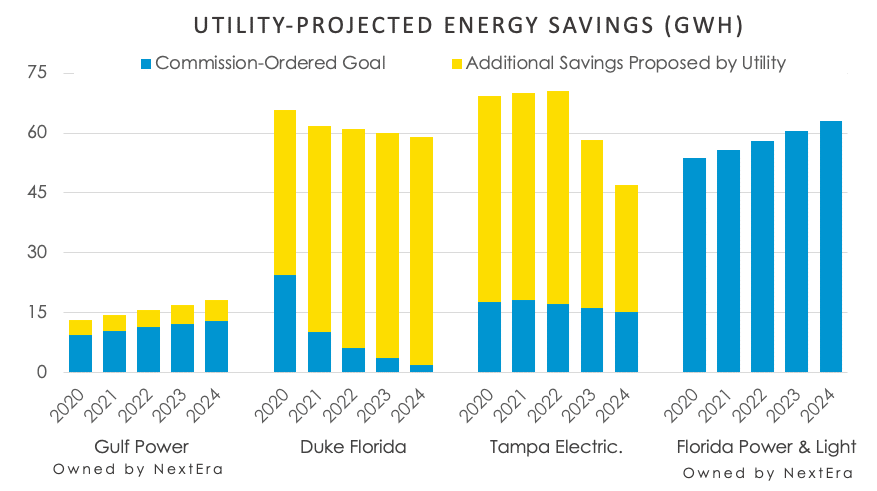
Preparing for Disaster, and Recovering From it – Energy Efficiency is the Solution
As the data for 2020 comes in, it is hard to find a silver lining. But the lesson should be clear: our ability to meet and overcome challenges in uncertain times depends on the preparations we take before disaster strikes. In 2020, millions of families could not afford their energy bills, but this was a problem that had already existed below the surface for years. The solution is energy efficiency, plain and simple.
When utility efficiency programs shut down last March, thousands of workers lost their jobs. Last November, E4 the Future examined these impacts and showed how a re-investment in energy efficiency can help the economy recover and put people back to work. Once again, the solution is energy efficiency.
The key to breaking the downward spiral caused by energy unaffordability is to combine gradual repayment plans and some degree of debt forgiveness with energy efficiency services. This will lower future energy bills and provide steady access to electricity, a basic need that promotes home safety and security.
It is time our utilities and regulators in the Southeast finally acknowledged that energy waste is a cost we just can’t afford. Only then can we truly progress towards a more efficient and affordable clean energy future.
Find out more from our third annual “Energy Efficiency in the Southeast” report and blog series below:
Download the Report
Read the Report Series
Watch the report webinar
#SEEnergyEfficiencyReport2021
Original Source: https://cleanenergy.org/blog/the-pandemic-effect-efficiency-performance-and-energy-affordability-challenges-in-2020/


